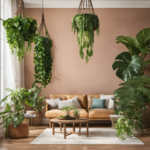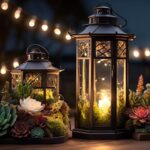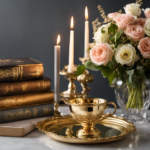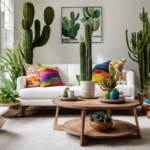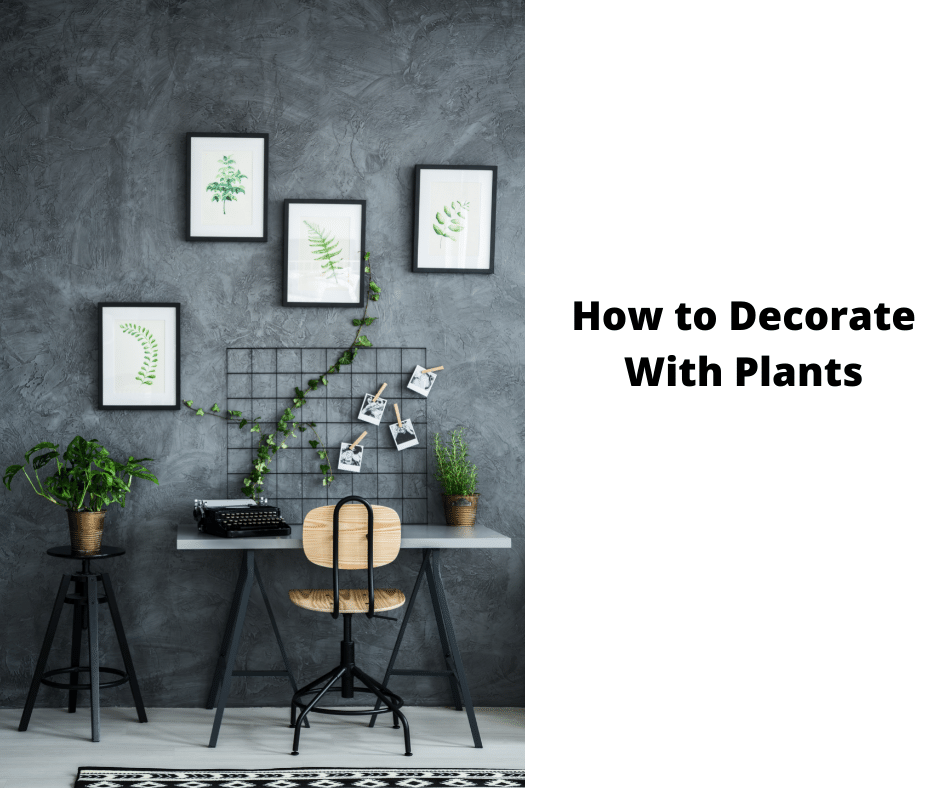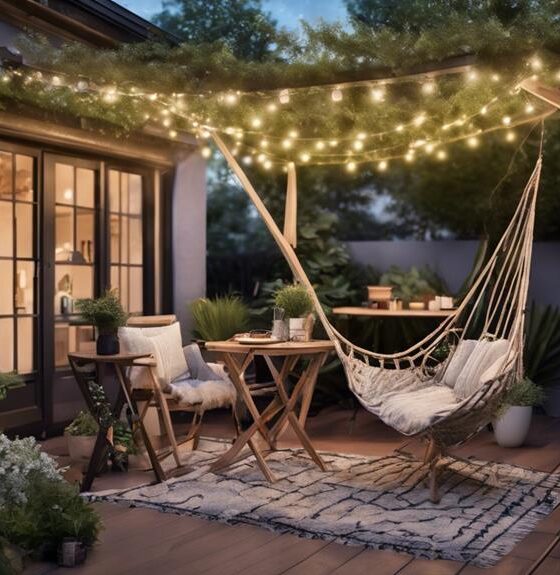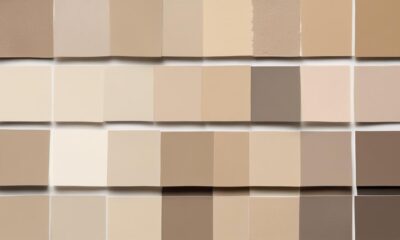Decor
What Decor Goes With Succulents
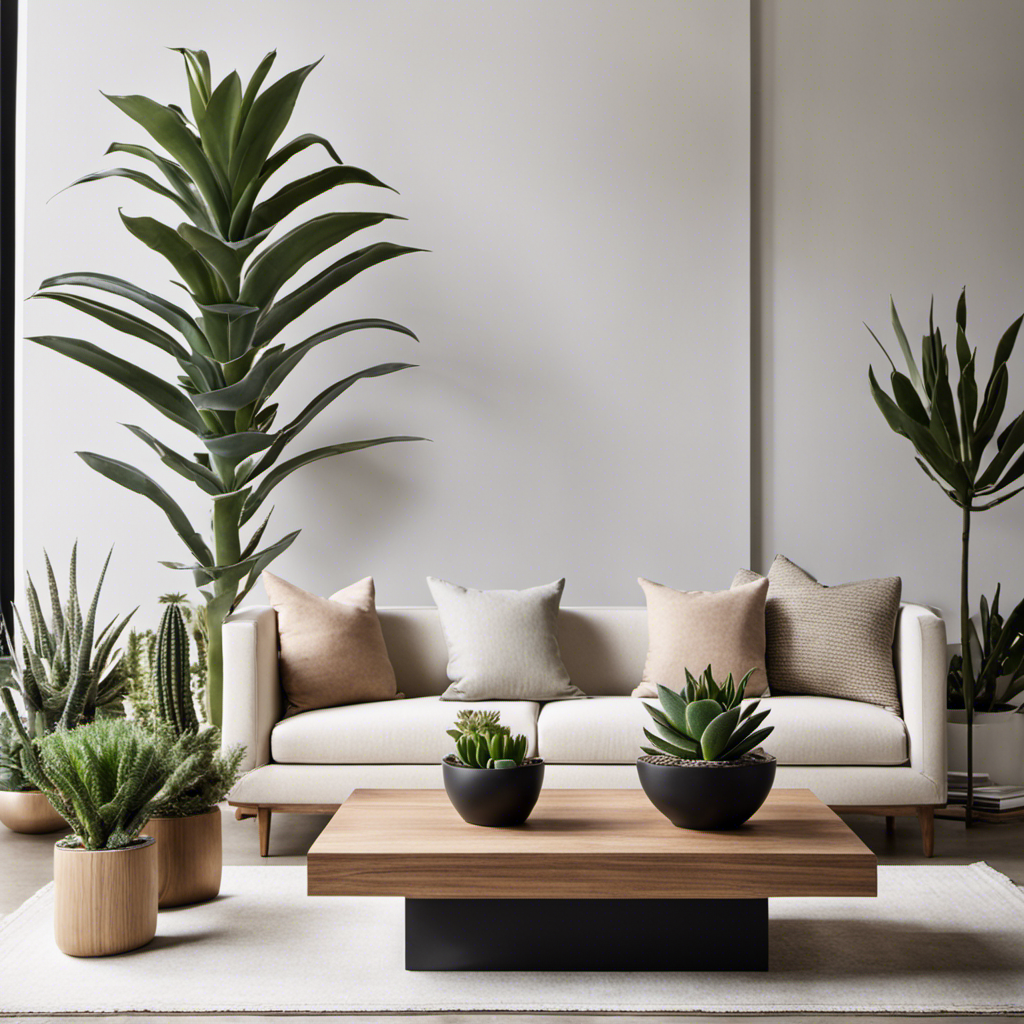
As I sat in my sunlit living room, surrounded by an array of vibrant succulents, a thought crossed my mind: what decor goes best with these delightful plants?
With their unique shapes and colors, succulents deserve a setting that truly complements their beauty. In this article, I’ll share my expertise on choosing the right containers, combining colors and textures, and creating a natural and organic look.
Get ready to transform your space into a succulent paradise that will leave everyone green with envy.
Key Takeaways
- Consider the size and drainage needs of succulents when choosing containers.
- Mix succulents with vibrant blooms or metallic accents for a pop of color and modern touch.
- Incorporate earthy elements like wood or stone into your succulent display for a natural look.
- Pair succulents with other plants like roses or geraniums to create dynamic and vibrant arrangements.
Choosing the Right Containers
When choosing containers for succulents, it’s important to consider their size and drainage needs. Succulents thrive in well-draining soil, so it’s crucial to select containers that have proper drainage holes. I recommend using terracotta pots or ceramic containers, as they allow excess water to escape easily. These materials also provide a stable environment for the plants, helping to prevent root rot.
Another thing to consider is the shape of the container. Mixing and matching shapes can add visual interest to your succulent arrangement. You can choose from round, square, or even geometric containers to create a unique and eye-catching display.
Additionally, be sure to select containers that are appropriate in size for your succulents, allowing them room to grow and spread their roots.
Complementing Colors and Textures
To create a cohesive look, it’s important to choose colors and textures that complement your succulents. By mixing succulents with vibrant blooms, you can add a pop of color and create a visually stunning display.
Imagine the contrast between the rich green hues of your succulents and the vibrant red, pink, or purple petals of flowers like geraniums or petunias. It’s a perfect way to add interest and depth to your arrangement.
Another option is pairing succulents with metallic accents. The smooth, sleek surfaces of metallic pots or decorative elements provide a modern and sophisticated touch to your succulent display.
The combination of the natural textures of the plants and the shiny metallic finishes creates a stunning visual contrast. It’s a great way to make your succulents stand out and add a touch of elegance to any space.
Creating a Natural and Organic Look
For a natural and organic look, consider incorporating earthy elements like wood or stone into your succulent display. Not only will these materials enhance the overall aesthetic, but they will also create a harmonious blend between nature and modern interiors.
In modern design, succulents have become a popular choice for adding a touch of greenery and tranquility to indoor spaces. By combining sleek, minimalist furniture with the vibrant colors and textures of succulents, you can create a visually stunning and contemporary look.
Additionally, DIY succulent arrangements are a fantastic way to bring life to your outdoor spaces. Whether you choose to use terracotta pots, driftwood, or natural stone, these handmade creations will add a unique and personal touch to your garden or patio.
Incorporating Succulents in Different Spaces
If you’re looking to add a touch of nature to various areas in your home, consider incorporating succulents. These versatile plants can be used in a variety of spaces, from outdoor gardens to small living areas.
Here are three unique ways to incorporate succulents into different spaces:
-
Create unique succulent arrangements for outdoor spaces: Whether it’s a patio, balcony, or garden, succulents can add a pop of color and texture to your outdoor areas. Try arranging different types of succulents in a planter or hanging them in a vertical garden for a stunning display.
-
Incorporate succulents in small living spaces: If you’re short on space, succulents are the perfect solution. They come in a variety of sizes and shapes, making them ideal for small pots or terrariums. Place them on windowsills, shelves, or even hang them from the ceiling to bring a touch of nature to your living space.
-
Mix and match succulents with other plants: Succulents can be paired with other plants to create beautiful and unique arrangements. Combine them with trailing vines, colorful flowers, or even herbs for an interesting and dynamic display.
Styling Succulents With Other Plants
When incorporating other plants into your space, consider mixing and matching them with succulents for a unique and visually appealing display. Succulents, with their interesting shapes and textures, can complement a variety of other plants, including flowering plants and cacti. By combining different types of plants, you can create a dynamic and vibrant arrangement that adds depth and interest to your space.
To give you some ideas, here is a table showcasing how you can pair succulents with other plants:
| Succulent | Flowering Plant | Cactus |
|---|---|---|
| Echeveria | Roses | Barrel |
| Haworthia | Geraniums | Prickly Pear |
| Sedum | Petunias | Golden |
Mixing succulents with flowering plants can create a beautiful contrast between the softness of the flowers and the boldness of the succulent leaves. On the other hand, pairing succulents with cacti can highlight their shared desert origins and create a cohesive desert-themed display.
Frequently Asked Questions
How Often Should I Water My Succulents?
I water my succulents once every 1-2 weeks, allowing the soil to dry out completely between waterings. Overwatering can lead to root rot, so it’s important to look out for signs of excess moisture, like yellowing or wilting leaves.
Can Succulents Be Grown Indoors?
Succulents can thrive indoors, offering many benefits. They purify the air, add a touch of greenery, and require minimal care. As a beginner, start with easy-to-grow varieties like Echeveria or Aloe Vera.
What Are Some Common Pests That Can Affect Succulents?
Common pests that can affect succulents include mealybugs, spider mites, and aphids. To prevent and treat these pests, regularly inspect your plants, remove any affected leaves, and use organic insecticides or neem oil if necessary.
Are There Any Specific Soil Requirements for Succulents?
When it comes to succulents, soil composition is vital. They thrive in well-draining soil, like a sponge that never stays wet. As for fertilizers, a balanced one with low nitrogen is best.
How Do I Propagate Succulents?
When propagating succulents, it’s important to choose the right pots. Opt for shallow containers with good drainage, like terra cotta or ceramic. These materials allow for proper airflow and moisture control, ensuring your succulents thrive.
What Holiday Decor Can I Pair With Succulents?
When it comes to pairing succulents with popular holiday decor 2019, there are several options to choose from. Consider combining succulents with miniature string lights for a whimsical touch or placing them in decorative holiday-themed planters. Additionally, you can adorn your succulents with festive ornaments or incorporate them into a centerpiece display alongside other seasonal elements. The possibilities are endless to create a unique and eye-catching holiday decor using succulents.
Conclusion
In conclusion, when it comes to decorating with succulents, it’s all about finding the perfect pairing.
Choose containers that are unique and eye-catching, like vintage teacups or geometric terrariums.
Mix and match colors and textures, combining spiky succulents with soft, velvety plants for a visually stunning display.
Don’t be afraid to go for a natural and organic look, incorporating elements like driftwood or pebbles.
And remember, succulents can thrive in any space, from a windowsill to a hanging planter.
So get creative and let your succulents shine alongside other plants.
Happy decorating!
- About the Author
- Latest Posts
Meet Bethia, the visionary designer at ByRetreat who brings a touch of magic to every remote workspace she creates. With a boundless imagination and an eye for beauty, Bethia is passionate about transforming ordinary spaces into extraordinary havens of creativity and comfort.
Bethia possesses a unique talent for envisioning the perfect combination of furniture, colors, and textures that harmonize seamlessly in a room. She understands that selecting furniture goes beyond mere functionality; it’s about curating pieces that evoke a sense of style and sophistication while enhancing the overall ambiance.
Architecture Home Styles
Exploring the Key Characteristics of Chinese Interior Design
Yearning to uncover the mysteries of Chinese interior design? Embark on a journey where tradition meets modernity in a captivating blend of elegance and culture.
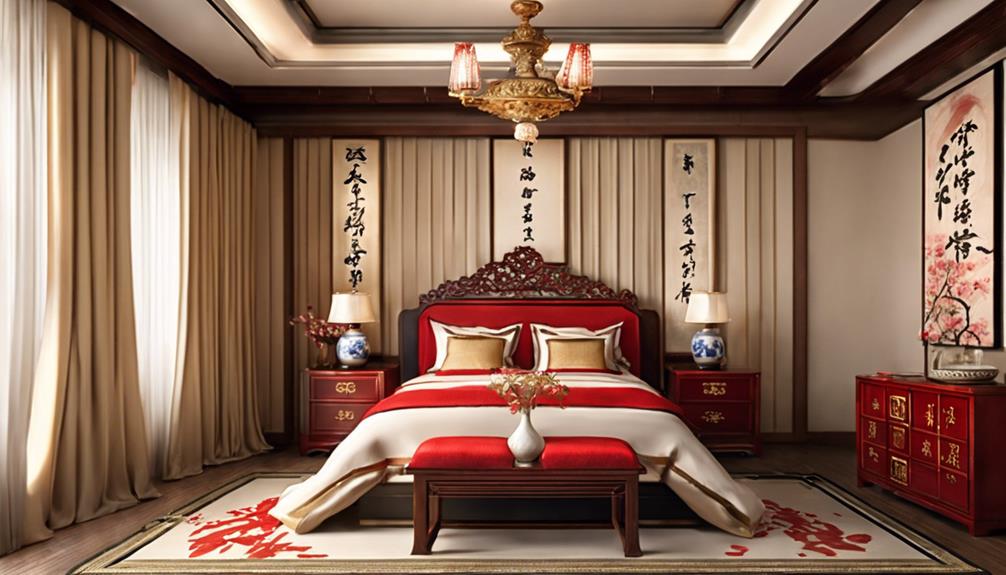
As we step into the realm of Chinese interior design, we find ourselves immersed in a tapestry of culture and elegance, where each element tells a story of tradition and innovation.
The interplay between ancient wisdom and contemporary design sensibilities in Chinese interiors is a fascinating journey of discovery. From the graceful curves of moon gates to the intricate patterns of silk brocades, the allure of Chinese interior design beckons us to explore a world where every detail holds significance.
Let's unravel the secrets behind the serene beauty and timeless appeal of this art form together.
Key Takeaways
- Incorporating traditional Chinese motifs enriches aesthetic appeal and cultural significance.
- Utilizing natural materials like wood and bamboo reflects traditional values and sustainability.
- Implementing Feng Shui principles ensures balanced energy flow and promotes harmony.
- Harmonizing Yin and Yang balance creates a tranquil and balanced environment for positive energy flow.
Traditional Chinese Motifs
Incorporating traditional Chinese motifs into interior design brings a sense of harmony and symbolism that enriches the overall aesthetic appeal. In Chinese culture, these motifs, such as dragons, phoenixes, lotus flowers, and lucky clouds, hold deep significance.
Dragons symbolize power and strength, instilling a sense of authority and majesty into the space. On the other hand, phoenixes represent rebirth and renewal, bringing a touch of rejuvenation to the environment.
Lotus flowers symbolize purity and enlightenment, adding a sense of tranquility and serenity. Meanwhile, lucky clouds are a common motif symbolizing good luck, longevity, and auspiciousness, inviting prosperity and good fortune into the surroundings.
Feng Shui Principles
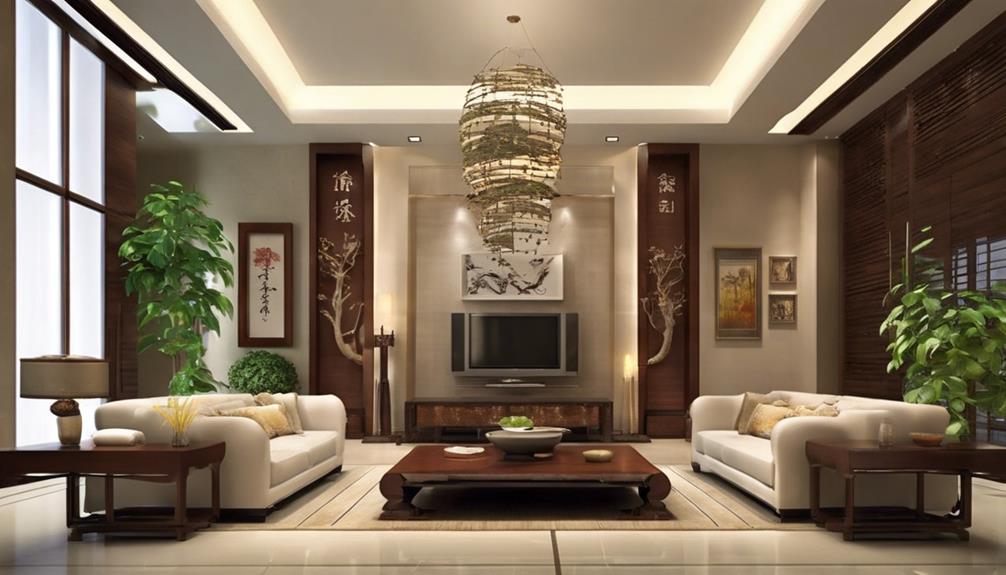
Implementing Feng Shui principles in Chinese interior design ensures a harmonious and balanced energy flow throughout the space. By carefully considering the placement of furniture and decor items, we can enhance positive energy and create a sense of harmony in Chinese interiors.
Feng Shui elements such as water, wood, fire, earth, and metal are strategically integrated to promote balance and well-being. The use of natural materials and symmetrical arrangements further contribute to the overall harmony of the space.
Symmetry plays a crucial role in Feng Shui, as it signifies stability and order, enhancing the flow of positive energy. By adhering to Feng Shui principles, Chinese interiors become not just aesthetically pleasing but also supportive of a healthy and prosperous lifestyle.
The thoughtful placement of decor items in accordance with Feng Shui guidelines ensures that every element contributes to the overall balance and positive energy within the space.
Use of Natural Materials
Embracing the essence of nature, Chinese interior design gracefully weaves natural materials like wood, bamboo, and stone to craft spaces that exude harmony and balance. Bamboo, a symbol of virtue and harmony with nature, is increasingly favored for its sustainability. These natural materials not only reflect traditional Chinese values and cultural beliefs but also create a tranquil ambiance, promoting a deeper connection to the environment.
The inclusion of bamboo and wood infuses spaces with warmth, texture, and authenticity, elevating the overall aesthetic appeal. By integrating these elements, Chinese interior design achieves a unique blend of modern innovation with timeless tradition. This harmonious fusion not only enhances the visual appeal of a space but also fosters a sense of peace and balance, inviting occupants to experience the beauty of nature within their surroundings.
In essence, the use of natural materials in Chinese interior design serves as a bridge between traditional values and contemporary design, creating spaces that resonate with tranquility and authenticity.
Decorative Symbolism
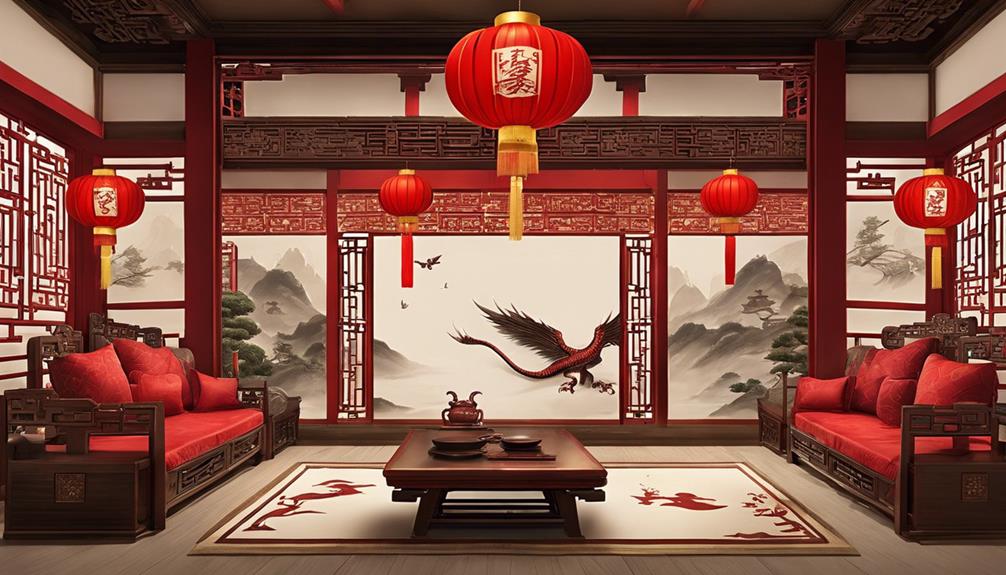
Symbolism in Chinese interior design beautifully intertwines cultural significance with decorative elements, infusing spaces with profound meaning and harmony. In Chinese design, decorative symbolism plays a crucial role in creating a harmonious living space that reflects cultural beliefs and artistic expression.
Some key elements of decorative symbolism in Chinese interior design include:
- Jade Sculptures: Representing purity, integrity, and tranquility, jade sculptures bring a sense of balance and serenity to a space.
- Porcelain Vases: Symbolizing wealth, prosperity, and good fortune, porcelain vases add elegance and grace to the décor.
- Calligraphy Scrolls: With characters that hold deep meanings, calligraphy scrolls bring wisdom, knowledge, and cultural richness to the design.
- Symbolic Colors: Colors like red for happiness, black for protection, gold for wealth, and white for purity are carefully chosen to promote positive energy flow and enhance the ambiance.
Harmonious Yin and Yang Balance
In the dance of design, Yin and Yang intertwine to create a harmonious equilibrium in Chinese interior spaces. Balancing contrasting elements such as light and dark, soft and hard, Yin and Yang bring forth a positive energy flow and a peaceful atmosphere.
Yin, representing feminine qualities like darkness and softness, complements Yang, symbolizing masculine attributes such as light and hardness. This harmonious blend fosters tranquility and balance in Chinese-inspired interiors, elevating the space to a realm of serenity and beauty.
Frequently Asked Questions
What Are the Characteristics of Chinese Interior Design?
We believe Chinese interior design embodies balance, harmony, and simplicity. Natural elements like wood, bamboo, and stone are prominent, reflecting a connection to the earth.
Traditional principles draw from Feng Shui, promoting positive energy flow. The color palette features muted tones with occasional pops of vibrant hues.
Symmetry, meticulous attention to detail, and decorative elements are all vital in creating spaces that exude the essence of Chinese-inspired design.
What Are the Chinese Concepts Related to Interior Design?
We believe that Chinese interior design concepts are deeply rooted in harmony, balance, and symbolism. By integrating Feng Shui principles and utilizing natural elements like wood and stone, Chinese design creates spaces that promote tranquility and connection to nature.
Incorporating symbolic elements such as dragons and flowers infuses meaning and tradition into the design. Chinese calligraphy and strategic use of screens further enhance the cultural richness and functionality of interior spaces.
What Is the Chinese Art of Interior Design?
Oh, the Chinese art of interior design? It's all about balance, harmony, and simplicity. We blend Feng Shui principles to infuse positive energy.
Natural elements like wood and bamboo create a minimalist vibe. Ruby reds and ebony hues are our go-to for that oriental touch.
Details matter; they capture the essence of Chinese design. It's a beautiful dance of tradition and innovation, creating spaces that speak to the soul.
What Are the Characteristics of Feng Shui Interior Design?
We believe Feng Shui interior design embodies harmony and balance.
It utilizes strategic placement of furniture and elements like water, wood, fire, earth, and metal to enhance energy flow. Symbols like dragons and flowers are integrated to attract positive energy.
The art of Chinese calligraphy adds an artistic touch.
This design approach promotes a harmonious and balanced environment, creating a space filled with positive energy and good fortune.
Conclusion
As we journey through the intricate tapestry of Chinese interior design, we're reminded of a delicate dance between tradition and modernity. Like a graceful lotus blooming in a tranquil pond, each element harmoniously intertwines to create a space that resonates with balance and symbolism.
Just as the gentle breeze whispers through the bamboo forest, Chinese interior design whispers stories of elegance, tranquility, and cultural richness. It's a symphony of beauty that soothes the soul and nourishes the spirit.
- About the Author
- Latest Posts
Introducing Ron, the home decor aficionado at ByRetreat, whose passion for creating beautiful and inviting spaces is at the heart of his work. With his deep knowledge of home decor and his innate sense of style, Ron brings a wealth of expertise and a keen eye for detail to the ByRetreat team.
Ron’s love for home decor goes beyond aesthetics; he understands that our surroundings play a significant role in our overall well-being and productivity. With this in mind, Ron is dedicated to transforming remote workspaces into havens of comfort, functionality, and beauty.
Architecture Home Styles
7 Essential Elements of American Style Interior Design
Wander through the world of American Style Interior Design and discover the hidden gem that elevates spaces to unparalleled heights.
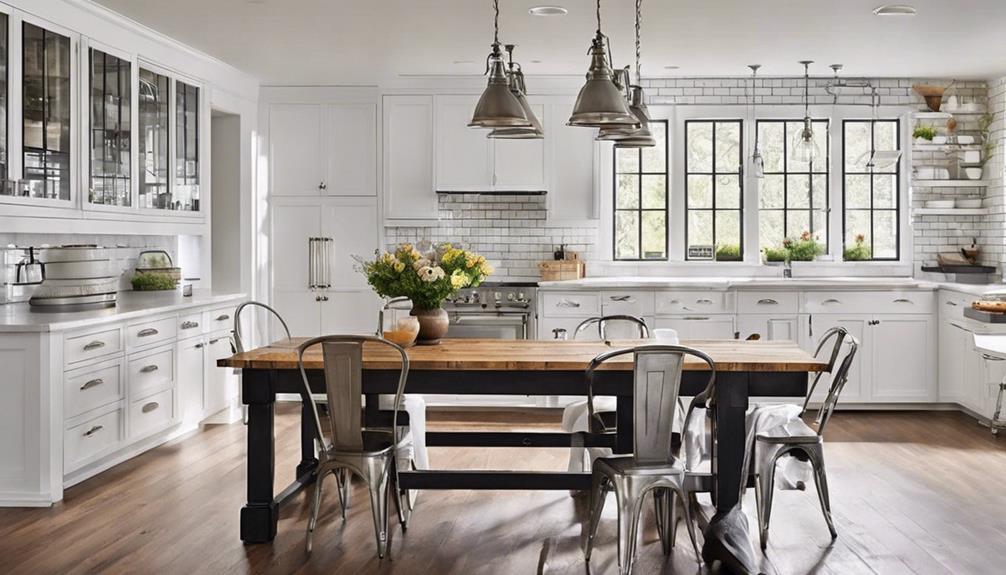
As we explore the intricate tapestry of American Style Interior Design, we uncover the seven essential elements that define its unique charm and versatility.
From the vibrant color palette that sets the tone to the careful selection of furniture pieces, each aspect plays a pivotal role in crafting a space that resonates with comfort and elegance.
However, there is a crucial element that often goes unnoticed but wields immense power in transforming a room into a sanctuary of style and sophistication.
Let's unravel this hidden gem together and unveil its impact on the overall design scheme.
Key Takeaways
- Neutral tones and accent colors create a timeless and balanced color scheme.
- Blend classic and modern furniture for a sophisticated yet functional look.
- Mix textures and fabrics for a cozy and inviting ambiance.
- Incorporate natural elements and strategic lighting for depth and charm.
Color Palette
When crafting an American style interior design, we carefully select a color palette that encompasses neutral tones such as beige, cream, gray, navy blue, and black to establish a timeless and sophisticated ambiance. These neutral tones serve as the foundation of the design, providing a versatile backdrop for various decor elements. To add depth and contrast, darker accents are often incorporated, enhancing the overall color scheme. By incorporating a mix of light and dark colors, we create visual interest and balance within the space, allowing for a dynamic and inviting atmosphere.
The versatility of these neutral color palettes allows for the seamless integration of different textures and materials, further enhancing the design scheme. Variation in shades within the neutral tones adds dimension and richness to the space, creating a harmonious environment. Whether it be through the use of soft fabrics, natural materials, or sleek finishes, the interplay of textures and materials adds layers of sophistication to the design.
Furniture Selection
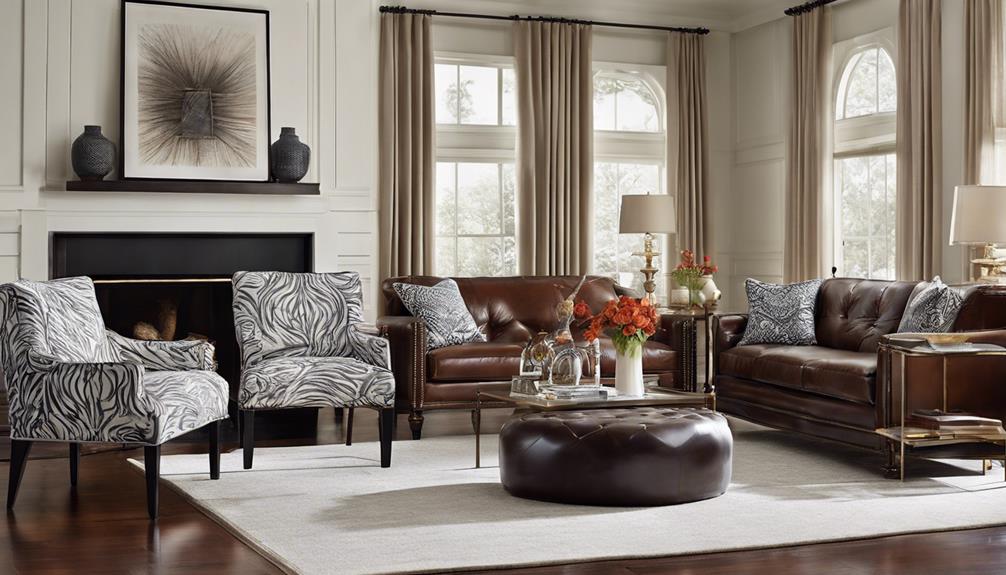
When selecting furniture for American style interiors, we blend classic and modern pieces to achieve a timeless appeal.
The interplay of color and texture in upholstery and wood finishes adds depth and character to the space.
Classic Vs. Modern
In the realm of American style interior design, the choice between classic and modern furniture selections sets the tone for the overall ambiance of a space.
Key Points:
- Classic Furniture: Incorporates traditional designs with ornate carvings, rich wood finishes, and elegant curves, reflecting a sense of history and sophistication.
- Modern Furniture: Embraces sleek lines, minimalistic designs, and a blend of materials like metal, glass, and polished wood, prioritizing clean aesthetics and functionality.
- Design Harmony: By combining classic elements like claw feet and cabriole legs with modern features such as geometric shapes and innovative materials, a dynamic and versatile mix of traditional and contemporary styles emerge, creating a unique and innovative interior design.
Color and Texture
Choosing furniture for an American style interior design involves carefully considering the interplay of color and texture to create a harmonious and inviting space. In American interiors, a neutral color palette serves as the foundation, with navy blue and black accents adding depth and contrast. Textures play a crucial role, ranging from soft textiles like plush cushions to sleek leather, blending comfort with sophistication. Furniture selection combines modern pieces with warm wood materials, fostering a cozy atmosphere. Area rugs are a common addition, providing comfort, defining spaces, and introducing varied textures. Rich textures, such as velvet or silk, elevate the tactile experience, infusing luxury into the room. Accent colors in strategic placements enhance the overall color schemes, adding vibrancy and visual interest.
| Color Schemes | Texture | Furniture Selection |
|---|---|---|
| Neutral Palette | Soft Textiles | Modern Pieces |
| Navy Blue Accents | Sleek Leather | Warm Wood Materials |
| Black Accents | Area Rugs | |
| Accent Colors | Rich Textures | |
| Velvet & Silk |
Textures and Fabrics
When it comes to American style interiors, the rich fabric choices play a crucial role in adding warmth and depth to the design.
Layering textures creatively can transform a space, creating a cozy and inviting atmosphere.
Mixing patterns tastefully is key to achieving that classic American look that's both stylish and comfortable.
Rich Fabric Choices
With a keen eye for tactile richness and visual allure, we immerse ourselves in the world of American style interior design through the exquisite realm of rich fabric choices.
- Plush Rugs: American design often incorporates plush rugs made of materials like wool or shaggy textures to add warmth and comfort underfoot.
- Silk Draperies: Soft textiles like silk are commonly used for draperies in American interiors, offering a luxurious and elegant touch to windows.
- Velvet Upholstery: The use of velvet for upholstery brings a sense of opulence and sophistication to furniture pieces, contributing to the overall richness of the space.
In American design, the strategic selection of fabrics such as these creates a harmonious blend of textures that elevate the ambiance of a room, making it inviting and visually captivating.
Layering Textures Creatively
Layering textures creatively in American style interior design involves intertwining a diverse array of fabrics and materials to infuse depth and visual intrigue into the living space. By combining various textures like soft textiles, sleek leather, and plush rugs, a tactile and inviting environment is created, elevating the comfort level and adding a cozy ambiance.
Fabrics such as velvet, linen, and silk are strategically chosen to enhance the overall aesthetic and evoke a sense of warmth. The thoughtful selection of materials plays a pivotal role in achieving a balanced and visually appealing look, crucial for the desired ambiance and style in American interior design.
This meticulous attention to layering textures results in a space that isn't only visually stimulating but also exudes a welcoming and harmonious atmosphere.
Mixing Patterns Tastefully
Intertwining a diverse array of fabrics and materials, American style interior design artfully mixes patterns and textures to create a visually captivating and cozy atmosphere. When it comes to mixing patterns tastefully, here are some key considerations:
- Layering Different Fabric Types: Incorporate a variety of soft textiles, area rugs, and textured elements to build depth and warmth in the space.
- Contrasting Scales and Designs: Balancing different scales, colors, and patterns helps achieve a harmonious and dynamic look.
- Adding Personality with Patterns: Integrate stripes, florals, geometrics, and solids to infuse the design with personality and character, creating an inviting environment that reflects your unique style.
Lighting Design
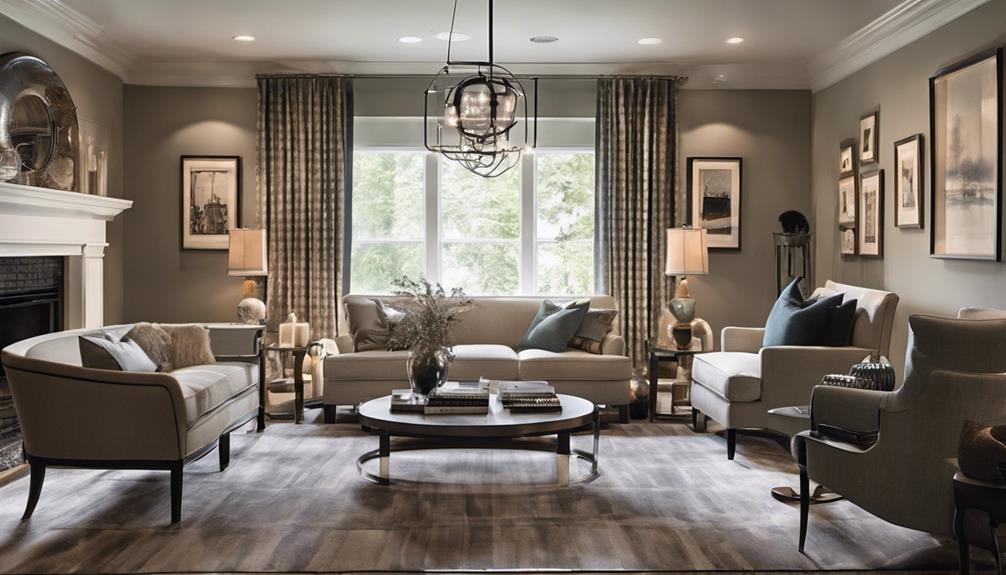
In American style interior design, the strategic placement of a mix of classic table lamps and contemporary floor lamps is crucial for accentuating design features and creating ambiance. Lighting design in this style focuses on layering light to add depth and warmth to the space. By incorporating both table and floor lamps, different elements within the room can be highlighted to contribute to the overall design concept.
The careful positioning of these lighting solutions not only enhances the functionality of the room but also elevates its visual appeal. American style interior design embraces the balance between classic and modern lighting fixtures, allowing for a seamless integration of traditional and contemporary elements. The interplay of light and shadows in a well-lit room enhances the ambiance, creating a welcoming and aesthetically pleasing environment.
Through thoughtful consideration of lighting design, American style interiors achieve a harmonious blend of functionality and style.
Art and Decor Elements
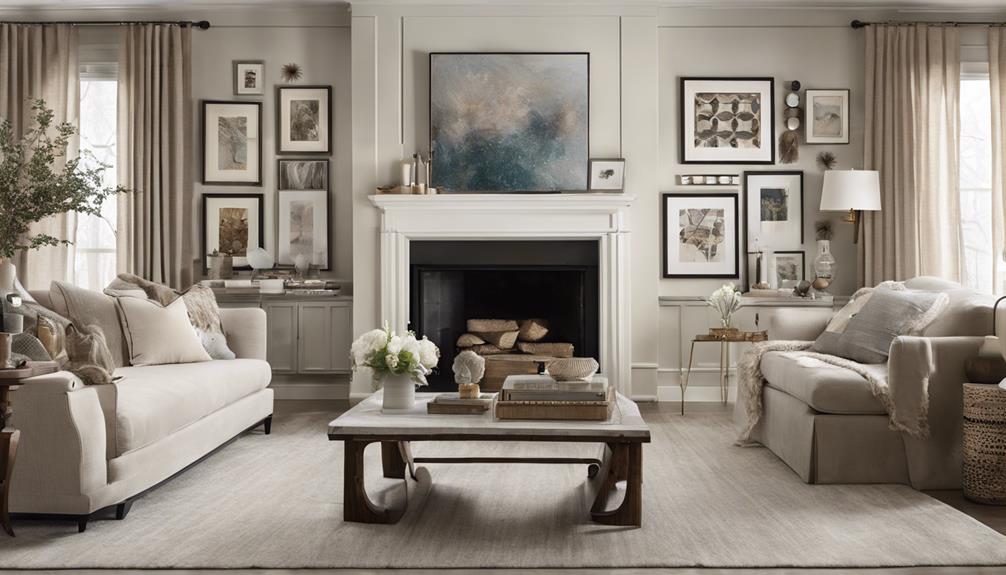
Art and decor elements play a pivotal role in American style interior design, serving as essential components that enhance the overall aesthetic appeal and personality of the space. In American interiors, art and decor are carefully curated to create a cohesive and visually stimulating environment. Here are three key aspects to consider when incorporating art and decor elements into American style interiors:
- Contemporary Art Pieces as Focal Points: American style design often integrates contemporary art pieces, such as abstract paintings or sculptures, as focal points in the decor scheme. These pieces add a modern touch and serve as conversation starters, elevating the overall ambiance of the space.
- Carefully Selected Items for Personality: Decor elements like vases, sculptures, and books are meticulously chosen to reflect the homeowner's personality and style. These carefully selected items inject character into the space, making it feel unique and inviting.
- Visual Interest through Art Integration: Thoughtful integration of art and decor enhances the visual interest of American style interiors. Whether through bold artwork or unique decor pieces, the mix of modern and traditional elements creates a harmonious balance that captivates the eye and draws attention to key design features.
Layout and Flow
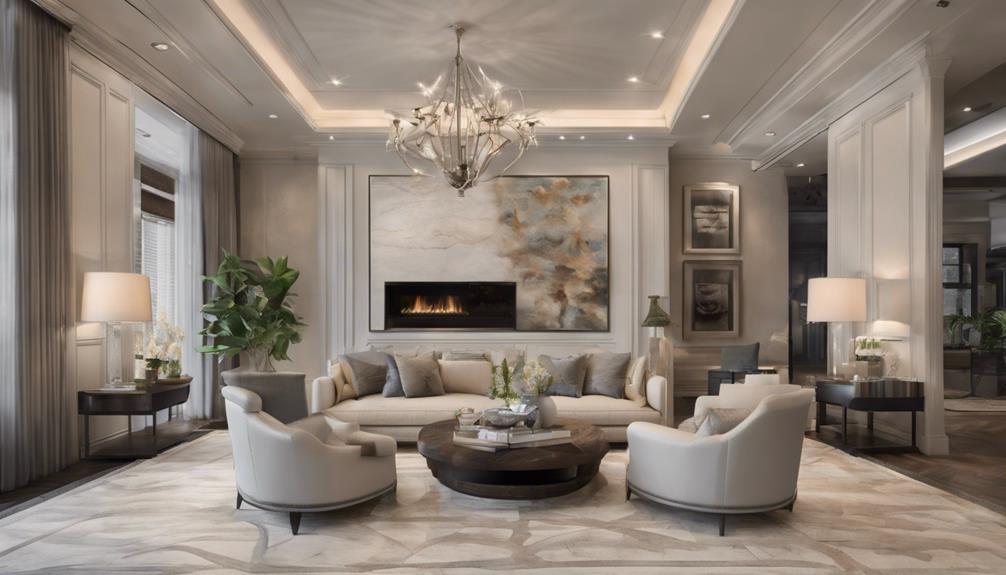
Incorporating the principles of art and decor seamlessly into American style interiors, we now shift our focus to exploring the strategic approach to layout and flow within these design spaces. American style interior design emphasizes open and spacious layouts to promote movement and interaction. Strategic furniture placement plays a vital role in creating distinct areas for various activities like lounging, conversation, and relaxation.
To achieve a harmonious balance and ensure continuity in the design, the flow of the space is carefully considered. Maintaining an organized and clutter-free aesthetic is essential in American style interiors to enhance openness. The layout is structured to facilitate a seamless transition between different areas of the home, enhancing the overall flow and functionality of the design.
| Key Elements | Description |
|---|---|
| Furniture Placement | Strategic placement to create distinct functional areas within the space. |
| Openness | Emphasis on open and spacious layouts to promote movement and interaction. |
| Organization | Maintaining a clutter-free aesthetic to enhance the sense of openness. |
| Harmonious Balance | Careful consideration of flow to achieve a perfect balance between function and aesthetics. |
Integration of Natural Elements
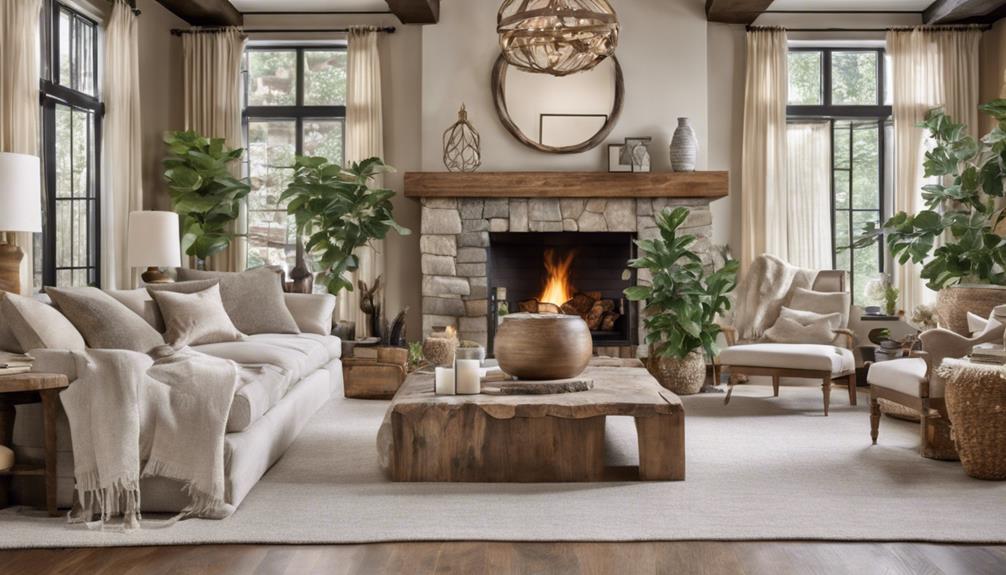
Exploring the seamless integration of natural elements into American style interior design enhances the warmth and organic charm of the space while promoting an eco-friendly appeal.
- Natural Elements: Incorporating materials like wood and stone into the design scheme brings a sense of nature indoors, creating a tranquil and earthy ambiance. These elements can be featured in various ways, from wooden furniture pieces to stone accents in the form of countertops or wall features.
- Plants and Greenery: Adding greenery to the interior not only enhances the aesthetic appeal but also improves air quality and overall well-being. Plants introduce vibrant colors, textures, and a refreshing atmosphere, making the space feel alive and connected to the outdoors.
- Textures and Colors: Utilizing natural textures and earthy colors in decor choices further enhances the organic charm of the design. From rustic wooden floors to neutral stone finishes, these elements add depth and character, creating a harmonious balance between the interior environment and the natural world outside.
Frequently Asked Questions
What Are the Elements of American Style Interior Design?
We blend old and new elements in American style interior design to create a timeless and inviting aesthetic. Our warm color palette, diverse furniture styles, and varied textures cater to various tastes.
Lighting is key, with classic table lamps and modern floor lamps strategically placed to enhance design features. Our focus is comfort, usability, and flexibility, offering a familiar and cozy ambiance.
Our inspiration spans Colonial, Victorian, Arts and Crafts, Mid-Century Modern, and Contemporary styles.
What Are the Key Elements of American Country Interior Design?
We believe that the key elements of American country interior design truly capture the essence of rustic charm.
The use of natural materials like wood and stone, warm color palettes, and traditional patterns create a cozy and inviting atmosphere.
Furniture with distressed finishes, vintage pieces, and comfortable upholstery add to the relaxed feel.
Decor accents such as farmhouse elements and handcrafted crafts further enhance the authentic American country style.
What Is American Traditional Interior Design Style?
American traditional interior design style blends Colonial, Victorian, Arts and Crafts, and Mid-Century Modern influences.
It embraces warm colors, varied furniture styles, patterns, and textures for comfort.
Timelessness, flexibility, and adaptability cater to diverse design preferences.
Lighting is crucial for ambiance.
What Is the 7 Elements of Interior Design?
We believe that understanding the 7 elements of interior design is essential for creating captivating spaces. Space, line, form, light, color, texture, and pattern all contribute to the overall aesthetic and functionality of a design.
Each element brings a unique quality, from defining shapes to setting the mood with light and color. Incorporating texture and patterns adds depth and visual interest.
Mastering these elements allows for innovative and inspiring interior design solutions.
Conclusion
As we wrap up our exploration of the essential elements of American style interior design, it's clear that each component plays a vital role in creating a harmonious and inviting space.
Just like a beautifully crafted quilt, these elements come together to form a cohesive and comforting environment that reflects the rich cultural heritage and timeless elegance of American design.
So, next time you step into a room with American style decor, remember the intricate tapestry of elements that make it truly special.
- About the Author
- Latest Posts
Introducing Ron, the home decor aficionado at ByRetreat, whose passion for creating beautiful and inviting spaces is at the heart of his work. With his deep knowledge of home decor and his innate sense of style, Ron brings a wealth of expertise and a keen eye for detail to the ByRetreat team.
Ron’s love for home decor goes beyond aesthetics; he understands that our surroundings play a significant role in our overall well-being and productivity. With this in mind, Ron is dedicated to transforming remote workspaces into havens of comfort, functionality, and beauty.
Architecture Home Styles
What Defines the Differences Between Classic and Modern Design?
Navigate through the contrasting realms of classic and modern design to uncover the essence that defines their differences – a journey of aesthetics and philosophies awaits.
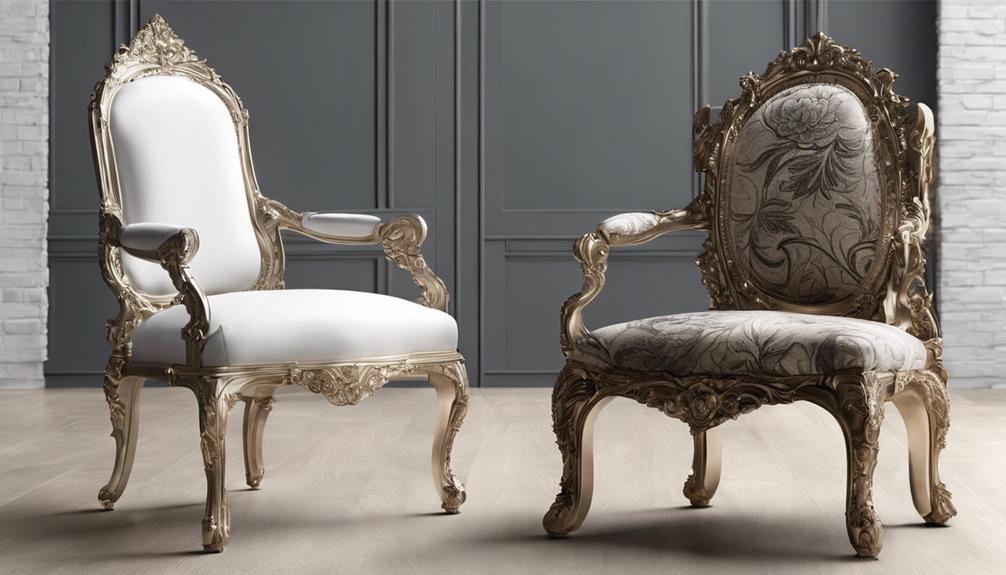
When exploring the distinctions between classic and modern design, we find ourselves navigating through a realm of contrasting aesthetics that have shaped our surroundings in unique ways. Classic design draws on tradition and elegance, while modern design embraces innovation and minimalism.
What truly sets them apart lies in their approach to form, function, and the underlying philosophy that dictates every detail. Join us as we unravel the intricacies of these design philosophies and uncover the essence that defines their differences, shedding light on the evolution of styles that continue to influence our living spaces.
Key Takeaways
- Classic design embodies opulence and tradition, while modern design focuses on simplicity and functionality.
- Classic design draws inspiration from 18th and 19th-century European architecture, while modern design is influenced by Bauhaus and Scandinavian styles.
- Classic design features richness, warmth, and vibrancy, while modern design emphasizes clean lines, neutrality, and minimalism.
- Blending classic and modern styles creates harmonious spaces by integrating traditional aesthetics with contemporary features.
Historical Roots of Classic Design
The historical roots of classic design can be traced back to the opulent and refined decor styles of 18th and 19th-century European architecture, embodying a blend of elegance and comfort. Classic design, as a style, draws inspiration from historical architectural movements such as Baroque and Gothic, reflecting a rich tradition of craftsmanship and artistry. This design approach appeals to aficionados of antiques, classic art, symmetry, and historical elements, creating a sense of timelessness and sophistication. What distinguishes classic design from other styles is its ability to transcend eras by incorporating modern elements, resulting in a unique and harmonious living experience that seamlessly blends the old with the new.
Within classic design, core themes such as symmetry, vibrancy, rich textiles, and a welcoming atmosphere prevail, creating spaces that exude a sense of grandeur and sophistication. By combining traditional elements with modern sensibilities, classic design continues to evolve, offering a timeless aesthetic that caters to those seeking a balance between historical charm and contemporary living.
Characteristics of Classic Design
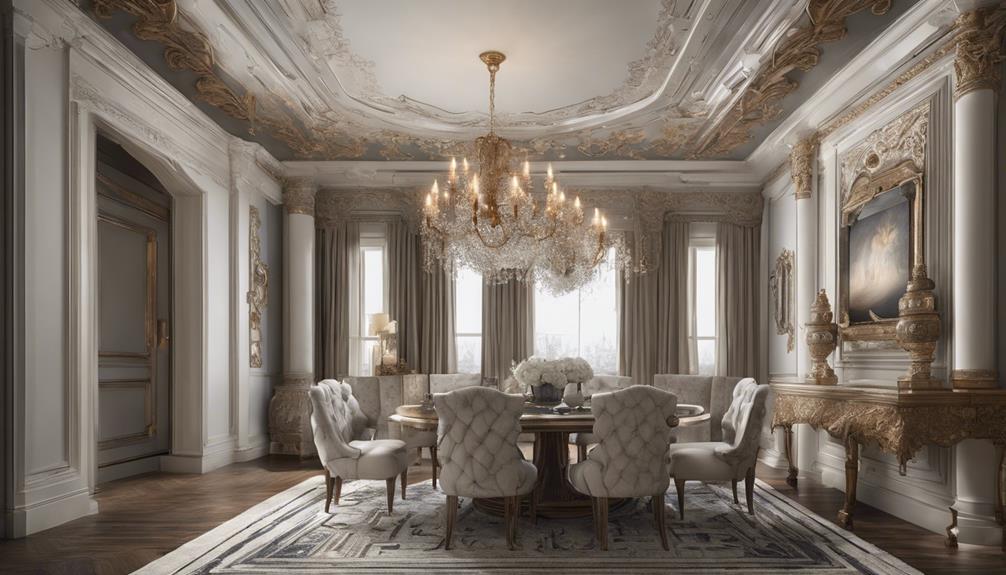
Portraying a harmonious blend of historical elegance and modern sensibilities, classic design embodies a timeless sophistication that transcends eras. Classic design, often referred to as 'Modern Classic,' draws inspiration from 18th and 19th-century European décor, characterized by its emphasis on elegance and comfort. This style appeals to individuals who appreciate antiques, classic art, symmetry, and history, creating a welcoming and familiar ambiance within living spaces.
Incorporating neutral colors, classic design integrates modern elements to offer a unique living experience while maintaining a focus on warmth, richness, and vibrancy. Symmetry, rich textiles, and the showcasing of extraordinary art pieces with captivating stories are core themes within classic design.
Unlike being confined to a specific era, classic design transcends time by drawing from tradition, making it appealing to individuals of all ages with its timeless sophistication. This style encapsulates a sense of refinement and grace, making it a popular choice for those seeking a harmonious balance between the past and the present.
Evolution of Modern Design
Drawing upon the roots of classic design, the evolution of modern design in the early 20th century marked a significant departure from traditional styles, emphasizing simplicity, functionality, and minimalism as core principles. Influenced by movements like Bauhaus and Scandinavian design, modern design took shape with clean lines, geometric shapes, and the use of industrial materials. As modern design continued to evolve, there was a noticeable shift towards open floor plans, the integration of natural light, and the incorporation of technology and innovation into living spaces.
Post-war modernism in the mid-20th century brought about an emphasis on practicality, affordability, and mass production. This era saw the rise of mid-century modern aesthetics, characterized by sleek lines, organic curves, and a focus on simplicity.
Fast forward to contemporary modern design, and we witness a further evolution embracing sustainable practices, eco-friendly materials, and a seamless integration of indoor and outdoor living spaces. The contemporary modern design ethos continues to push boundaries, marrying functionality with aesthetic appeal in innovative ways.
Key Elements of Modern Design
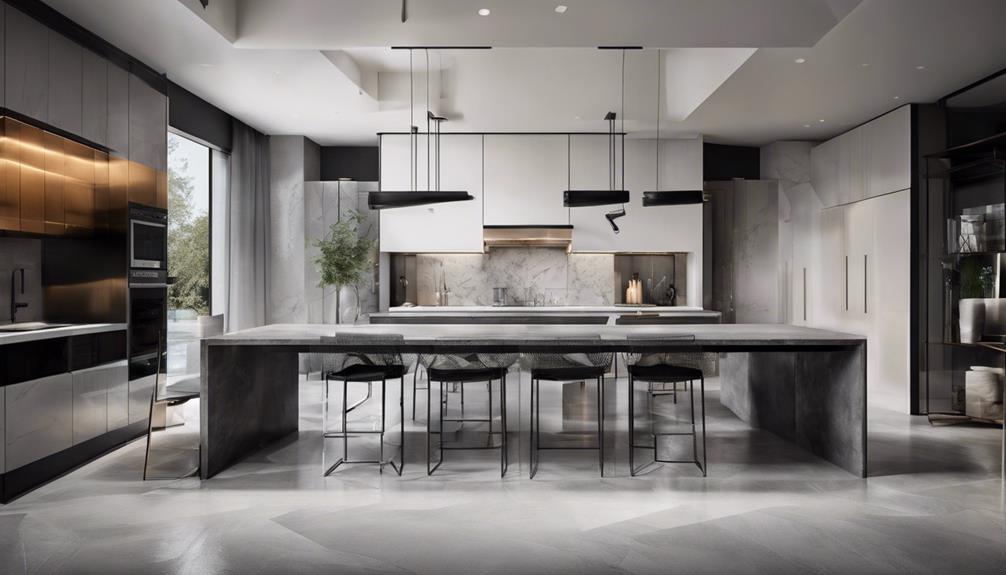
Emphasizing clean lines, simplicity, and a neutral color palette, modern design incorporates key elements that contribute to its distinctive aesthetic appeal and functionality.
In modern interior design, the color palette is often subdued, featuring shades like white, beige, gray, and black to create a sense of calm and sophistication. Modern furniture plays a crucial role in achieving this look, with pieces characterized by sleek lines, geometric shapes, and a focus on functionality. Materials such as wood and plastic are commonly used to add a contemporary touch to the interior space.
Additionally, modern design often incorporates minimalistic artwork and decor to maintain an uncluttered environment. Big window panes are favored to invite natural light into the space, enhancing the overall ambiance. Open floor plans and strong, defined lines are also prevalent features in modern interior design, emphasizing a sense of spaciousness and organization.
Influenced by German and Scandinavian styles, modern design blends practicality with natural elements to create a clean and visually appealing aesthetic.
Blending Classic and Modern Styles
To synthesize classic and modern design elements effectively, one must carefully balance traditional aesthetics with contemporary features. Blending classic and modern styles involves the strategic integration of traditional design elements with sleek lines, traditional furniture, neutral colors accented by pops of color, and simple patterns. Influential designers such as Studio McGee and influencers like Chris Loves Julia have popularized this approach, showcasing how vintage furniture and decor can be seamlessly incorporated to achieve a unique and balanced aesthetic.
Interior designers often opt for a 3/4 to 1/4 ratio of modern to traditional furniture when blending classic and modern styles. This ratio helps strike a harmonious balance between the two design aesthetics, ensuring that neither the classic nor the modern elements overpower the space. By skillfully combining elements from both the classic and modern styles, interior designers can create spaces that are both timeless and contemporary, appealing to individuals who appreciate the fusion of tradition and innovation in interior design.
Frequently Asked Questions
What Is the Difference Between Modern and Traditional Design?
When comparing modern and traditional design, we observe distinct contrasts. Modern design emphasizes simplicity and functionality, employing clean lines and neutral tones.
In contrast, traditional design showcases ornate details, rich colors, and intricate patterns. These differences extend to furniture choices, with modern design favoring minimalistic pieces while traditional design incorporates classic furniture elements.
Understanding these disparities helps us appreciate the unique characteristics of each design style.
What Is the Difference Between Modern and Classic House Design?
When comparing modern and classic house designs, we notice distinct contrasts in style, function, and aesthetic appeal.
Modern design embraces minimalism, clean lines, and functionality, fostering a sense of simplicity and spaciousness. In contrast, classic design exudes elegance through rich tones, traditional furniture, and intricate details, evoking a sense of timelessness and sophistication.
These differences cater to personal preferences, with modern design embodying trendiness and classic design embodying tradition and comfort.
What Is the Difference Between Classical and Contemporary Design?
When comparing classical and contemporary design, one can observe a stark contrast in styles and aesthetics. Classical design exudes elegance through rich tones, intricate textures, and ornate decorative elements such as crystal chandeliers.
In contrast, contemporary design embraces minimalism with clean lines, neutral colors, and a focus on functionality. The differences are evident in the use of materials, color palettes, and overall design philosophy, showcasing the evolution of design trends over time.
What Is the Difference Between Classic and Traditional Design?
When comparing classic and traditional design, we notice distinctions in their origins and stylistic elements. Classic design draws from 18th and 19th-century European décor, emphasizing elegance and symmetry.
In contrast, traditional design encompasses a broader range of styles from various historical periods, incorporating more ornate details and decorative elements.
Understanding these differences helps us appreciate the unique characteristics and influences that shape each design style.
Conclusion
In conclusion, the differences between classic and modern design can be likened to the contrast between a vintage library filled with ornate furniture and a sleek, futuristic art gallery.
While classic design exudes elegance and tradition with its timeless materials and intricate details, modern design embraces simplicity and functionality with its clean lines and minimalist approach.
By understanding and blending elements from both styles, one can create a harmonious and unique aesthetic that transcends time.
- About the Author
- Latest Posts
Introducing Ron, the home decor aficionado at ByRetreat, whose passion for creating beautiful and inviting spaces is at the heart of his work. With his deep knowledge of home decor and his innate sense of style, Ron brings a wealth of expertise and a keen eye for detail to the ByRetreat team.
Ron’s love for home decor goes beyond aesthetics; he understands that our surroundings play a significant role in our overall well-being and productivity. With this in mind, Ron is dedicated to transforming remote workspaces into havens of comfort, functionality, and beauty.
-

 Mardi Gras Decoration4 weeks ago
Mardi Gras Decoration4 weeks agoWhen Should I Decorate for Mardi Gras?
-
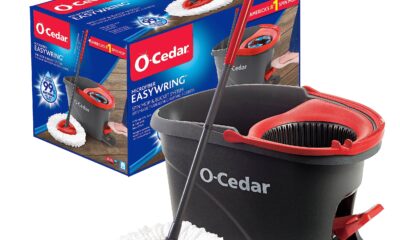
 Vetted2 weeks ago
Vetted2 weeks agoBest Mop for Sparkling Clean Floors in 2024
-

 Christmas Decoration4 weeks ago
Christmas Decoration4 weeks agoWhy Does Eastern Orthodox Have a Different Christmas?
-

 Carnival Decoration4 weeks ago
Carnival Decoration4 weeks agoCan I Add Someone to My Carnival Cruise Room After Booking?
-

 Carnival Decoration4 weeks ago
Carnival Decoration4 weeks agoCan You Get an Extension on Carnival Cruise Payments?
-

 Christmas Decoration3 weeks ago
Christmas Decoration3 weeks agoDoes Orthodox Christmas Have Santa?
-

 Carnival Decoration4 weeks ago
Carnival Decoration4 weeks agoCan You Get Balloons Filled at Family Dollar?
-

 Christmas Decoration3 weeks ago
Christmas Decoration3 weeks agoWhat Happened to Christopher Radko?




